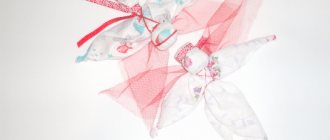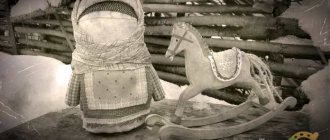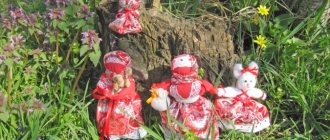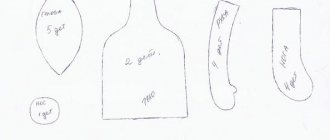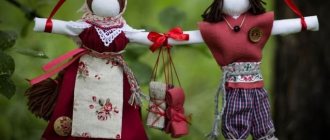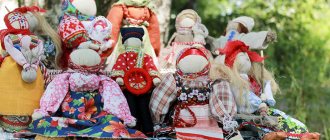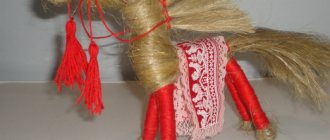The Vepsian doll is a powerful family amulet that helps a woman get married and protect her children. Traditionally, the cradle was placed on the window before the wedding, and then stored in the baby’s cradle.
Why is the Vepsian doll called Kapustka? How is it different from other reels? How to make it correctly? In our article you will find answers to these questions, and as a bonus you will find a simple master class on how to make this talisman.
How did the Vepsian doll appear?
Every culture has its own amulets. These are not only ancient symbols or small figurines in the form of gods or mythical creatures, but also dolls. The last type of amulet in our latitudes gained particular popularity, because it was made from the simplest and cheapest materials.
The Cabbage doll represents female maturity and fertility.
The guest of our conversation today, the Cabbage doll, also belongs to such amulets. Experts still doubt what to call it correctly - Cabbage, Nurse, Vepsian doll or Rozhanitsa? Each of these names was adopted by different nationalities at one time.
The doll is called “cabbage” because it is the personification of female maturity and fertility. The name “Feeder” came from here. In a family, a man is usually considered the breadwinner, but here a completely different meaning is implied - a mother feeding her child.
There is also a name “Vepsian doll”. According to this version, the Vepsians, representatives of a small people now living in Karelia, the Vologda and Leningrad regions of the Russian Federation, were the first to start making the Cabbage doll. Many people disagree with this point of view, believing that the name simply took root in everyday life, because such reels were made by other peoples long before the Vepsians.
The exact period of appearance of the Vepsian doll, like most folk dolls, is unlikely to be established. Historical sources are full of inaccuracies, and some of them are completely lost. We only know that at one point such an amulet appeared and remained in our culture.
Feeder doll - history and meaning
The rag doll Feeder should have appeared in Russian people in any case.
After all, we have already said that the ancient Slavs lived a slightly different life. Their existence took place on the border of the worlds - tangible and unknown. The invasion of otherworldly energy into the material world, as a rule, did not end with anything good, so it was necessary to warn, protect, secure people from the action of evil spirits, avert the evil eye and neutralize anger, envy and hatred. This is how amulets appeared, the main ones among which were Slavic amulets dolls. In order to live happily and calmly, one had to think about absolutely everything - the health of the household (Kubishka-Travnitsa), the safety of babies (Pelenashka), the safety of the harvest (Krupenichka), family well-being (Lovebirds), home comfort - everything had to be under control . So, in this situation, how can one not think about ensuring that the whole family is fed to its fullest, and that they always live in harmony with each other in the house? Therefore, along with all the rest of her rag friends, the Nurse doll appeared, which was entrusted with exactly this.
Feeder doll, view from the back
A distinctive feature of shawl dolls, as well as some others (for example, the Motanka doll), is the obvious presence of breasts in the rag figurine, on which increased attention is focused. In this regard, it is necessary to clarify that in this case the large breasts of the doll do not contain erotic overtones, but are a manifestation of distant echoes of matriarchy
In those days, the supreme Slavic deities were associated with women, therefore all images, sculptures, statues, figurines and, naturally, dolls made in honor of them had exaggerated signs of a female figure. Look, for example, at the wooden ancient idols in honor of the goddess Mokosh and many things will become clearer to you. This is how the most characteristic feature of the female figure - the breasts - was introduced into the design of the rag doll and remained forever, which in the doll symbolizes the participation of the most powerful of the unknown forces that the ancient Slavs worshiped.
This has a global meaning; there is no need to invent or specify anything in this regard, supplementing it with your fantasies and inventions. Despite her semi-joking name, the Nurse with her breasts feeds not only the baby with milk, but the whole family, the whole clan will always be well-fed and prosperous from her care. I hope you get the difference.
- Actually, although I don’t really like it when you start such explanations, this is a necessary clarification. And then there, our Spiridon Solstice still sometimes remembers how someone there wanted to turn him into a driver’s amulet.
- Yes, in our time this is not surprising. Although, how can one confuse the steering wheel of fate with the steering wheel? Well, it’s up to everyone to delve into the essence or see only what’s on the surface, but our goal is to tell our vision.
What role did the Cabbage doll serve?
Each protective motanka did her job - one doll protected the house from evil spirits, the other warded off illnesses, and the third made sure that the table was not empty. Such home amulets include a Vepsian doll. Her task was not an easy one - the Vepsian doll was responsible for a successful marriage, happiness and well-being of the family.
The Vepsian doll is a talisman for a successful marriage and a strong, happy family.
According to tradition, this doll was made before marriage. When it was time to look for a groom, the young craftswomen made Cabbage and then put it on the window. This was a signal that the girl was ready for marriage. At the same time, the Vepsian doll served as a kind of love amulet, helping to find the one betrothed.
When the matchmaking took place and the newlyweds finally settled into family life, the doll moved into the cradle. She protected not only the first-born, but also all subsequent children of the couple, just like Pelenashka, who was similar in properties. Protecting the baby from the unkind words of envious people and illnesses, the jerk filled the house with comfort and happiness.
How to activate Doll of Joy
When the doll is ready, this does not mean that it has become a full-fledged guardian. In order to endow it with magical properties, you need to speak to it correctly.
To do this, place the doll in the center of the table, place three wax (not church) candles around and say the text of the plot three times:
This is an appeal to Lada. This goddess was considered the mother of all existing ones, so the Slavs treated her with special reverence. If you are already familiar with Slavic culture, consider Lada your patroness, wear her Star or Cross, then you can also turn to the guardian in your own words and ask for happiness and prosperity.
Recently, the tradition of making beregin dolls has been revived. Many people want to have a Radostey doll in their home. Make a doll motanka with your own hands according to all the rules, and it will become the most powerful guardian of the hearth.
DIY Vepsian amulet doll
The advantage of doll amulets is not only that they are made from available materials, but also in their simplicity. The Vepsian doll is also quite simple to make. Even a young housewife who has no experience in needlework can make cabbage. The main thing is to be patient and believe that everything will work out.
Features of creating a doll-amulet
Nowadays men also do handicrafts - some of them knit sweaters or sew toys. But in the old days this activity belonged entirely to women. Men were strictly forbidden to help, not even allowed to spy on the process.
All materials for creating a Vepsian doll must be natural.
The secrets of creating amulets were passed down through the female line - from mother to daughter or from great-grandmother to granddaughter. Here is what advice previous generations left us:
- Dolls-motankas are made without the help of sharp objects. Scissors, needles, and other tools can only be used when creating blanks. All the shreds will have to be held together with threads.
- The Vepsian doll and other jerks do not have a face. This is not an omission from the craftswoman, but an attempt to protect the amulet from an attack by an evil spirit. After all, having taken possession of it, evil spirits can harm the owner of the doll.
- For rag dolls, the most beautiful, bright fabrics and colorful ribbons are chosen. All materials for Vepsian jerky must be natural, because this will affect the strength of the talisman.
You need to make a Vepsian amulet in one sitting, without interrupting other activities, so as not to deprive it of its power. A young craftswoman can ask for help from her elders - grandmother, mother, aunt.
Master class: DIY Cabbage doll
Materials:
- white fabric 25x25 cm (for the body);
- pieces of colorful fabric 25x25 cm (for a sundress and chest);
- a piece of colored patterned fabric 20x20 (handkerchief);
- a piece of light (but not white) material 5x12 (apron);
- filler (cotton wool or yarn);
- red thread;
- two colored threads (any color except red);
- a piece of wide ribbon 6 cm (warrior);
Step by step guide
- Clothes for Cabbage are wrapped over the body, so we will start with it, namely the head. Lay the white fabric out on a flat surface and then roll the filling into a ball. Place in the center of the scrap.
- Forming the head. To do this, you need to lift each corner of the fabric up with one hand, and grab the ball with the other and straighten out the folds on it. After this, secure the ball by tying it with a thread.
- Place the workpiece back on the table with the ball facing up. We straighten the pieces of material on the sides, and tie a thread along the edges of the triangles - these will be the doll’s palms.
- We level the fabric from below, mark a belt and tie it under the arms with thread. On the chest we make a protective cross from the same threads.
- Put the workpiece aside. Now we will make curvaceous shapes for the doll. They are made according to the principle of creating a head - we roll a ball from the filler, wrap it in fabric, and tie it under the ball with thread. We repeat the procedure once.
- We hook the workpiece-chest. Tips down, balls up and wrap with thread again. At the same time, these two parts are also a skirt.
- Now we’ll make a dress for the Vepsian doll. We take pieces of fabric for it and, in turn, perform the same action with each of them - fold it in half.
- We bend the edges of the triangle inward to form a rhombus, and then unfold them to the sides, like a paper airplane.
- We fasten these three blanks on the sides and on the back, and wrap them with thread in the waist area.
- We bend the scrap for the apron in half and apply it to the belt. Lifting the upper part, we stretch the thread there and tie it around the waist. We tie a lace woven from two threads on top.
- We decorate the doll's head with a warrior, tying it at the back. Now you can put a scarf on the doll. Make sure to tie the ends behind your back so they are not visible.
While working, the craftswoman is supposed to be in a good mood. She should be cheerful and healthy. If you have a headache or more serious health problems, postpone making the Vepsian amulet until better times.
Motanka is ready!
Protective doll Ryabinka
lysenok Guest Traditional amulet doll Ryabinka is one of the most powerful female dolls. Rowan - A symbol of female wisdom, motherhood and hearth. In Rus', mothers were treated with reverence, and the Rowan tree was treated the same way; they didn’t break it in vain, they knew about its protective properties. Ryabinka’s name day was celebrated four times a year, and Ryabinka was made when the fruits ripened - on the fourth name day, in the fall. Rowan is a talisman of family happiness in the house, protects true love from misfortunes and troubles. Since ancient times in Rus', the branch of this flexible and, in general, not the most powerful, in the opinion of an ignorant person, tree was a symbol of Perun’s club. Rowan is the berry of Perun, the thunder god.
TREE of protection, spirit and wisdom. Tree of Thor, Mars and Jupiter, Freya. It is believed that Romulus' dart was made from rowan wood. Rowan is one of the 12 sacred trees of Scandinavia. This beauty is actually a warrior tree, capable of giving a very tough rebuff to the influence of evil. The mountain ash very harmoniously combines the earthly and heavenly principles. “A rowan tree and a red thread make witches less playful,” says a famous Scottish proverb. Just holding something made from rowan in your hands already heals and protects from evil. In order to constantly be protected by rowan, the ancestors of today's Scots made amulets: crosses from rowan twigs, tied with red thread. Rowan can drive away Morok from a person and return him to the real world. To do this, its branches are harvested on any of the rowan nights. They are tied with red thread or yarn in the form of an equal cross. Witches' staffs and sticks are carved from rowan trees. A rowan cross was worn around the neck and hung from the harness of horses, over the beds of newlyweds and the cradle of infants. And since she is also a Lelya tree, Rowan Day is celebrated in autumn and spring. In spring - May 1, in autumn - September 24. Images of rowan are as effective as the mountain itself, which is why it was depicted on vessels and towels. Autumn Rowan or Sparrow Nights. This is seven days between September 14 and September 22. Rowan berries are harvested. The doll is hung opposite or near the entrance doors and, like a warrior, does not allow anything negative into the house. The doll protects true love from misfortunes and troubles; it is the strongest amulet of family happiness in the house. Made on a cross made of rowan, the doll has magical properties, such as relieving depression, removing damage from the evil eye, and protection from the energies of the dead world. Well, as always, we follow the rules for making protective dolls.
The nuances of making a doll
Since Radosteya is a real ritual doll, it must be made according to all the rules. If you violate the basic canons according to which our ancestors made such amulets, then the resulting product will be an ordinary toy, and not a magical bereginya. Therefore, if you decide to start creating Joy, then follow all the established rules.
Prepare in advance all the scraps of fabric from which the doll will be made. It is advisable not to cut the material with scissors, but to tear it with your hands. Our ancestors were sure that the sound of tearing material scared away evil spirits. The reel should not only be uncut, but not split.
If you come across master classes in which a doll's outfit or body parts are sewn to each other, then you know that a keeper prepared in this way will be a simple souvenir. The use of needles is strictly prohibited. When creating a beregin, it is advisable to use only one very long and strong thread.
Almost always, our ancestors focused attention on the fact that knots can only be on the doll’s navel and on her arms. Therefore, refrain from using different short threads and tying them in different places.
Popular articles DIY Christmas tree decorations, a star made of threads. paper toys
Under no circumstances should Radostey's eyes, nose or mouth be depicted on her face. Ritual Slavic dolls cannot have a face.
Many modern people do not understand such a belief. But in fact it is very simple to explain. The Slavs believed that if a ritual symbol has eyes, then through them any evil spirits can inhabit this object. The absence of eyes was a guarantee that the evil spirit would not be able to take possession of the doll and harm the inhabitants of the house.
To make motanka, use new material or pieces of old “lucky” clothes of family members. It is prohibited to use clothing that belongs to sick or dead people.
Don’t interrupt your work and don’t leave an unfinished product “for later.” When creating a talisman, put the purest, brightest and warmest feelings into it.
What will you need for the job?
What materials are needed for needlework? Making a Vepsian doll is an interesting and not at all expensive activity. For it you will need:
- A square piece of white or beige color (head and arms). The size is determined depending on the growth of the future Cabbage; for a small doll, approximately 20 x 20 cm is enough.
- Colored square patches.
- Filler (cotton wool, rags, padding polyester, pieces of foam rubber).
- Threads for connecting parts (red).
- Materials for decorative details: lace, braid, etc. (optional).
Activation of the amulet
The transformation of a rag into a powerful amulet is ensured by the ceremonial ritual of activating the doll. Even during production, the words of the conspiracy were spoken for each knot. When the doll was ready, they placed it under the rays of the sun, sprinkled it with clean water and clearly formulated what the betrothed should be like. This is how Kapustka understood the message and its purpose.
In ancient times, there was another way to activate protective energy. Craftswomen made a Veles wheel on a doll. They took a red thread and wrapped it an odd number of times, first around the waist, then over the left and right shoulders in a figure-of-eight pattern, around the neck and finally on the belt.
Popular articles Felting wool toys. snowman with Christmas tree. master class with step-by-step photos
Hello, dear visitors of the KuklaStadt website!
Russian rag dolls are mostly made from scraps torn from a whole piece of material. Sometimes these flaps were wrapped around the base, and sometimes they were simply applied to the body and secured with thread.
“Um...” Veselina said in bewilderment, “have you decided to start all over again?” This has already been said a hundred times. How are you feeling?
“Come on, don’t be silly,” I answer, “now you’ll understand what I’m getting at.”
So, in connection with the above, the ancient Slavs simply called a doll, if it did not have its own name, simply because it was assembled from torn pieces of clothing. And, if such flaps were prepared in advance of the same size and were not wrapped around the doll, but folded in a special way and tied several pieces to the body, then it was the Handkerchief. This design was very simple, so they came up with the idea of making such dolls in several regions at once.
But, despite the external similarity, the purpose of handkerchief dolls with different registrations was also different - in one place it was a talisman with one meaning, in the second region they made a game doll, and in the third the amulet doll had a completely different meaning. Naturally, over the centuries, confusion began to arise, because the keepers of knowledge gradually left without leaving their instructions to their descendants.
Therefore, based only on external similarity and without going into details, many people began to unite all the dolls made according to the handkerchief type into one friendly company, equating, for example, the Nurse, the Cabbage and the Handkerchief itself. Meanwhile, these are all different dolls with their own characteristics and purposes, despite the fact that they look very similar and are made almost the same way.
- Who should we start with? – Veselina asks interestedly.
— Today I propose to tell you about the Feeder doll - a rag amulet for the satiety of all household members and the general well-being in the house.
History and role of the amulet
Ancient Slavic families were famous for their foundations. Everyone had responsibilities: the husband was the breadwinner, the head of the family, the woman was a good housewife and mother, the keeper of the family hearth, children were helpers from early childhood. From a young age, girls were taught to cook, sew, and do housework. It’s not surprising, because at that time people gave marriages early; from the age of 10, parents looked after the groom’s daughter.
The girls made Cabbage and put it on the window so that everyone could see that the bride had grown up in the house. And the grooms, and their parents, determined her readiness for family life by the appearance of a girl’s rag girlfriend. A good and even doll has a much greater chance of attracting the groom than a crooked and hastily made one.
In addition to the enticement in the window, the Vepsian doll participated in children's rituals. The girls took their rag girlfriends with them on a walk and showed them off to their friends. If the boy liked the girl, he would pick up her Cabbage and examine it. The owner could take the doll away, which symbolized refusal, or simply observe his actions, which expressed sympathy.
After the matchmakers arrived, the doll did not appear in the window, but it was hidden in the chest for a short time. Cabbage had a lot of work to do. Her mistress took her husband with her to the house, where she was to maintain harmony and well-being in the family.
When the baby was born, the doll was placed in the cradle or hung above it. The doll protected the baby from the evil eye and evil spirits. When the child grew up, the doll never got bored. There were many children in Slavic families, and they appeared one after another, and Kapustka in turn was the protector for each of them.
Radostey doll - history
The history of this doll goes back to ancient times. Our ancestors, the Slavs, worshiped many gods. Therefore, each deity had its own symbol, its own doll, which denoted the connection with this deity. Also, the Slavs made most of the ritual dolls in order to attract good luck, prosperity, and created little helpers for themselves.
It was believed that each doll retains the energy of the person who made it. Therefore, when creating such reels, people invested as much love, warmth, and tenderness into them as possible, so that all these positive emotions would pass on to the whole family or to the person for whom the amulet was made.
The Radostey doll in this case was no exception. She was a symbol of a woman who, with her hands raised, joyfully greets everyone who enters the house. It was believed that this little bereginya attracts positive energy into the house.
At the same time, such a talisman did not allow evil people, negative programs, evil and adversity into the home. Quite often these amulets were given as gifts.
The Radostey doll was an integral part of the life of our ancestors, just like Krupenichka, Podorozhnitsa, Travnitsa, Desyatiruchka and other common ritual dolls.
It was believed that if there is such a guardian in the house, then misfortunes will bypass you. Often such talismans were passed down through generations. The doll was made by the eldest woman in the family and passed on to the children's families.
